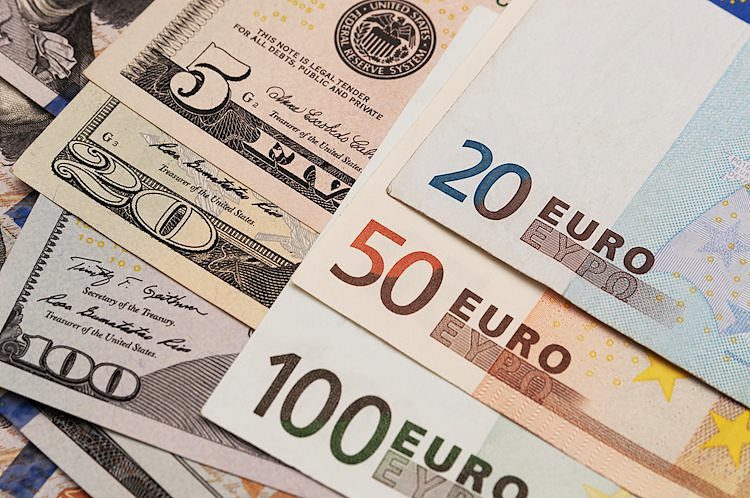- The Euro jumps to 1.1000 as the final US GDP disappoints.
- US economic growth revised down to 4.9% in the third quarter from the previous 5.2% estimation.
- The focus is now on the US PCE Price Index for more cues on the Fed’s policy outlook.
The Euro (EUR) extended gains on a thin pre-Cristmas session to reach session highs at 1.1000, following a downward revision of the United States (US) third quarter’s Gross Domestic Product (GDP). Recent data by the US Bureau of Economic Analysis revealed that the US economy grew at a 4.9% yearly rate, down from the preliminary estimations of a 5.2% increase.
Apart from that, the Philadelphia Fed Manufacturing survey signaled a further-than-expected deterioration in the region´s business conditions and the Personal Consumption Expenditures declined against expectations.
These figures have offset the positive impact of jobless claims data, endorsing the narrative of a soft landing and boosting hopes of the Federal Reserve’s (Fed) rate cuts in early 2024. This scenario increases the interest on Friday’s PCE Price Index, which is for further info about the timing of the US Central Bank´s next move.
Daily digest market movers: Euro reaches fresh highs after the downward US GDP revision
- US Q3 GDP revised to a 4.9% year-on-year growth from the previous 5.2% estimation.
- The Philadelphia Fed Manufacturing index dropped to -10.5 from -5.9 in November; the market expected a moderate improvement to -3.
- US Personal Consumption Expenditures eased to 2.6% in Q3, the consensus anticipated a 2.8% reading, unchanged from Q2.
- US Jobless claims increased by 205K from 203K in the previous week, well below the 215K expected.
- Fitch ratings anticipate slower global growth in 2024 and rate cuts by the Fed, the ECB, and the BoE.
- US data has hammered the Dollar sending the US Dollar Index (DXY) to test multi-month lows at 101.80.
- Investors are pricing a nearly 75% chance of a quarter-point rate cut in March followed by another one in May, according to data by the CME Group Fed Watch Tool.
- The main focus no is the US PCE Prices Index, due on Friday. The Fed’s preferred inflation measure is seen dipping below the 3% year-on-year rate for the first time in almost three years. A soft PCE inflation reading would increase bearish pressure on the USD.
Technical Analysis: Euro jumps to 1.1000 as US GDP data disappoints
From a technical perspective, the pair has regained bullish momentum to reach the 1.1000 psychological level, with the US Dollar index increasing bearish pressure. Euro bulls, however, are likely to be challenged at the 1.1010 area with investors reluctant to place significant bets against the USD ahead of Friday’s US PCE inflation data.
Above 1.1010, the next targets would be the August high at 1.1060, and the July 24 and 27 high at 1.1150.
To the downside, the pair should break the 1.0880 and the 4-hour 100 Simple Moving Average (SMA) at 1.0870 to increase bearish pressure. In this scenario, bears’ focus could shift towards 1.0825 on the way to December lows at 1.0715.
Euro price this week
The table below shows the percentage change of Euro (EUR) against listed major currencies this week. Euro was the weakest against the Swiss Franc.
| USD | EUR | GBP | CAD | AUD | JPY | NZD | CHF | |
| USD | -0.78% | 0.13% | -0.23% | -0.99% | 0.30% | -0.88% | -1.39% | |
| EUR | 0.78% | 0.91% | 0.56% | -0.20% | 1.08% | -0.09% | -0.59% | |
| GBP | -0.13% | -0.92% | -0.36% | -1.14% | 0.15% | -1.02% | -1.52% | |
| CAD | 0.23% | -0.57% | 0.35% | -0.77% | 0.52% | -0.66% | -1.17% | |
| AUD | 0.99% | 0.21% | 1.11% | 0.76% | 1.28% | 0.11% | -0.39% | |
| JPY | -0.30% | -1.09% | -0.16% | -0.52% | -1.29% | -1.19% | -1.69% | |
| NZD | 0.87% | 0.08% | 1.01% | 0.66% | -0.11% | 1.17% | -0.51% | |
| CHF | 1.36% | 0.59% | 1.51% | 1.16% | 0.39% | 1.67% | 0.51% |
The heat map shows percentage changes of major currencies against each other. The base currency is picked from the left column, while the quote currency is picked from the top row. For example, if you pick the Euro from the left column and move along the horizontal line to the Japanese Yen, the percentage change displayed in the box will represent EUR (base)/JPY (quote).
Economic Indicator
United States Personal Consumption Expenditures – Price Index (YoY)
The Personal Consumption Expenditures (PCE), released by the US Bureau of Economic Analysis on a monthly basis, measures the changes in the prices of goods and services purchased by consumers in the United States (US). The YoY reading compares prices in the reference month to a year earlier. Price changes may cause consumers to switch from buying one good to another and the PCE Deflator can account for such substitutions. This makes it the preferred measure of inflation for the Federal Reserve. Generally, a high reading is bullish for the US Dollar (USD), while a low reading is bearish.
